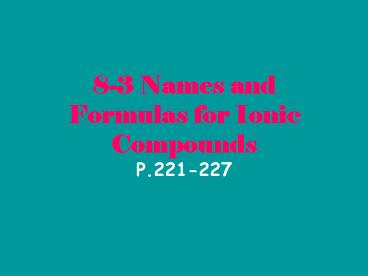8-3 Names and Formulas for Ionic Compounds - PowerPoint PPT Presentation
Title:
8-3 Names and Formulas for Ionic Compounds
Description:
8-3 Names and Formulas for Ionic Compounds P.221-227 Objectives Write formulas for ionic compounds and oxyanions Name ionic compounds and oxyanions Key Terms Formula ... – PowerPoint PPT presentation
Number of Views:176
Avg rating:3.0/5.0
Title: 8-3 Names and Formulas for Ionic Compounds
1
8-3 Names and Formulas for Ionic Compounds
- P.221-227
2
Objectives
- Write formulas for ionic compounds and oxyanions
- Name ionic compounds and oxyanions
3
Key Terms
- Polyatomic ion
- Oxyanion
- Formula unit
- Monoatomic ion
- Oxidation number
4
Formulas for Ionic Compounds
- A formula unit simplest ratio of ions
representing a compound - ALL ionic compounds are written as formula units
(not the case for covalent compounds)
5
Monoatomic Ions
- Monoatomic ions contain a single element
- Be2, Na, Fe3
- Notice the charge on the elements!
6
Polyatomic Ions
- Polyatomic ions have more than one element, with
a net charge - SO42-, NH4, NO2-, C2H3O2-
- Treat like a single unit, not individual ions
7
Naming Binary Ionic Compounds
- Step 1 Name the cation first and the anion
second. - Step 2 Monoatomic cations use the element name.
- Step 3 Monoatomic anions use the ion name with
the ide ending. - Step 4 For d-block cations you must write the
cation charge as a roman numeral in parentheses. - Step 5 If the compound contains a polyatomic
ion, just use the name of the ion.
8
Naming Binary Ionic Compounds
- Example
- NaCl Sodium Chloride
- FeO Iron (II) Oxide
- NH4Cl Ammonium Chloride
9
Writing a Chemical Formula from the Name
- Step 1 Write the element symbol for name of the
ion - Step 2 Write the charge of the ion
- Step 3 If the total charge equals zero, you are
done. If the total charge does not equal zero,
you must change the subscripts so that the total
charge equals zero (drop-n-cross).
10
- Writing a subscript for a polyatomic ion put a
parenthesis around it with the subscript on the
outside of the parenthesis - Example Cr(SO4)2
11
- Example Barium Fluoride
- Step 1 Ba F
- Step 2 Ba2F-
- Step 3 Total charge 1
- Step 4 BaF2
12
- Example Iron (III) Sulfate
- Step 1 Fe SO4
- Step 2 Fe3SO42-
- Step 3 Total charge 1
- Step 4 Fe2(SO4)
13
- Example Beryllium Oxide
- Step 1 Be O
- Step 2 Be2O2-
- Step 3 Total charge 0 ? BeO
14
Homework
- P.227 35-36,38-39
- P.237 74-79































